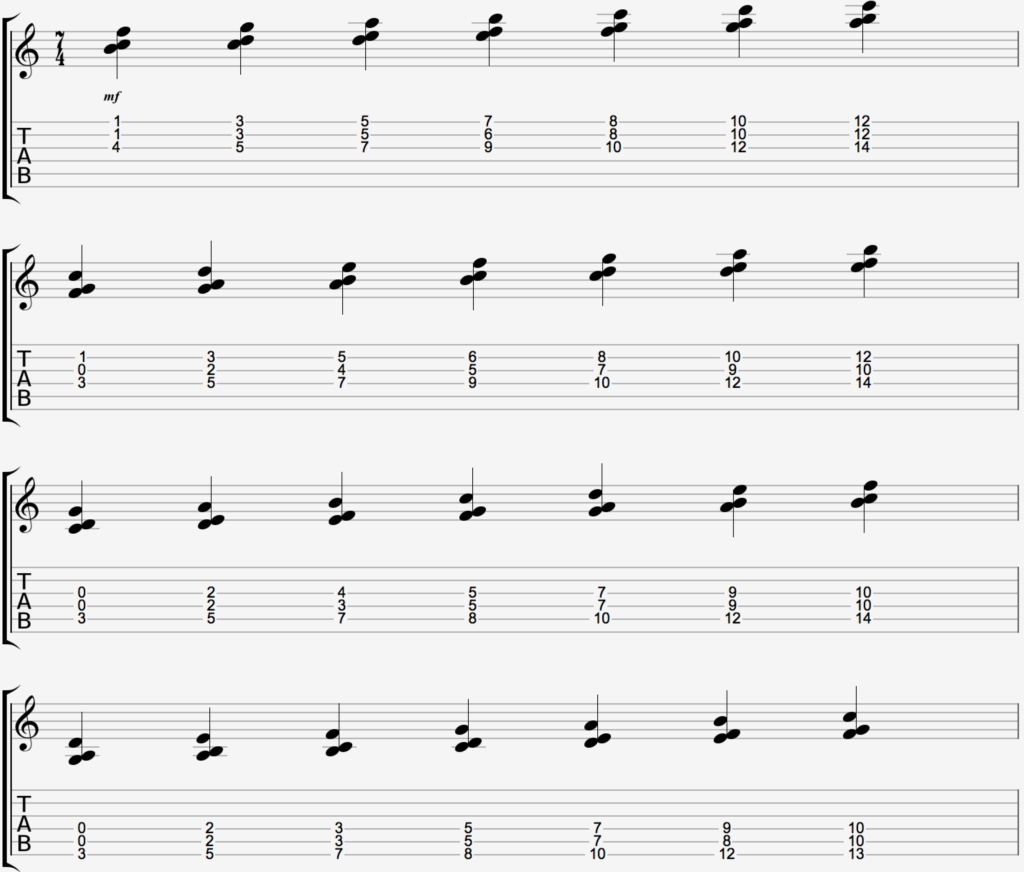Improvisation With 2nd and 4th Interval Stacks
When from any note, you play a note up a 2nd and then up a 4 from there, you get an inversion of a quartal harmony chord.
Quartal harmony is what you get when you stack two 4th intervals on top of one another.
You can learn more about quartal harmony here
For example, from low to high:
D G C
D to G is a 4th, and G to C is a 4th
This is the root position configuration.
The first inversion would be the notes: G C D
Looking at that configuration:
G to C is a 4th and C to D is a 2nd. We will discuss that inversion in upcoming week’s blog
When you invert those notes again, 2nd inversion, you get: C D G
C to D is a 2nd and D to G is a 4th.
These new sounds you may not be familiar with yet, are really cool voicings that you can use to create atmosphere, or to create interesting soloing/melody lines, or as cool pedal point sounds, or to spice up your rhythm playing.
You can hear in this song I wrote many years ago, called “(Con)Fusion Ba(ch)Rock”, how these quartal harmony chords can be used to create very creative, interesting melodies.
The whole melody consists of notes I arpeggiate in 1st and 2nd inversion quartal harmony chords.
It’s essential, that you first get a pretty good understanding of 2nd intervals and how to play them
https://www.zotzinguitarlessons.com/blog/the-study-of-music-intervals-on-guitar-part-2/
and 4th intervals
You might also be interested in reading up on Jon Damian’s “Palette Chart”
All this above info will help you get better use out of today’s topic: 24 (stacked 2nd + 4th interval)
When you stack a 2nd and a 4th on top of one another, you get 3-note chords that are neither major nor minor. They have a sus quality.
In a major scale, 5 of those 7 chords are going to be sus2 chords, and 2 chords (on III and VII) have a b2, which gives you note-combinations for which there isn’t really a chord name.
Here are the 7 chords in a C major scale.
C D G – Csus2
D E A – Dsus2
E F B – 1 b2 5
F G C – Fsus2
G A D – Gsus2
A B E – Asus2
B C F – 1 b2 b5
While there isn’t really a chord name in music theory for EFB or for BCF, that doesn’t mean you should discard these options.
As a matter of fact: these actually are pretty cool-sounding note combinations.
You could also think of these note combinations as being subsections of chords with a larger group of notes.
For example:
EFB could be thought of as part of E G# B D F, which is an E7b9 chord.
BCF could be thought of as part of B D# F A C, which is a B7b5b9 chord.
As shown above, you could of course also just think of EFB and BCF as note combinations in the key of C that there isn’t really a chord name for.
So now you know what the 3 notes are for all seven chords formed as a result of stacking a 2nd and a 4th in the key of C, you just need to figure out the chord shapes.
Best way to approach this: stick to 1 string set only, and play horizontally through all 7 chords.
Only 4 string sets to learn, here they are:

Here’s how to practice this:
- Start with the top 3 strings only.
- Spend some time getting all the fingerings memorized on that string set
- Play a C major or A minor backtrack.
- Solo with the chords
- You can either hit the chords as block chords or arpeggiate them
The following video shows how you would solo with 3-note chords.
The video uses regular triads (not the above 24 chords), but you will know how to solo with the above 24 quartal harmony chords after seeing this video.
Conclusion
Hit me up anytime at vreny@zotzinmusic.com if you have any questions, or if you would like to book a lesson.
The free lessons I offer on my blog are cool, but you will never experience the progress, joy, and results that my students experience in lessons when you’re learning by yourself from blogs and videos.
That is why people take lessons: way better results and progress, much more complete information, exposed to way more creative ideas than you can get from a blog or YouTube video.
There is only so much that self-study can accomplish.
If you want to see amazing results and progress in your guitar playing, buy your first lesson here and get started ASAP.
You’ll impress your friends and loved ones in no time with your guitar playing!
Consider donating any small amount to help me keep this blog going.
Thank you for your support!


